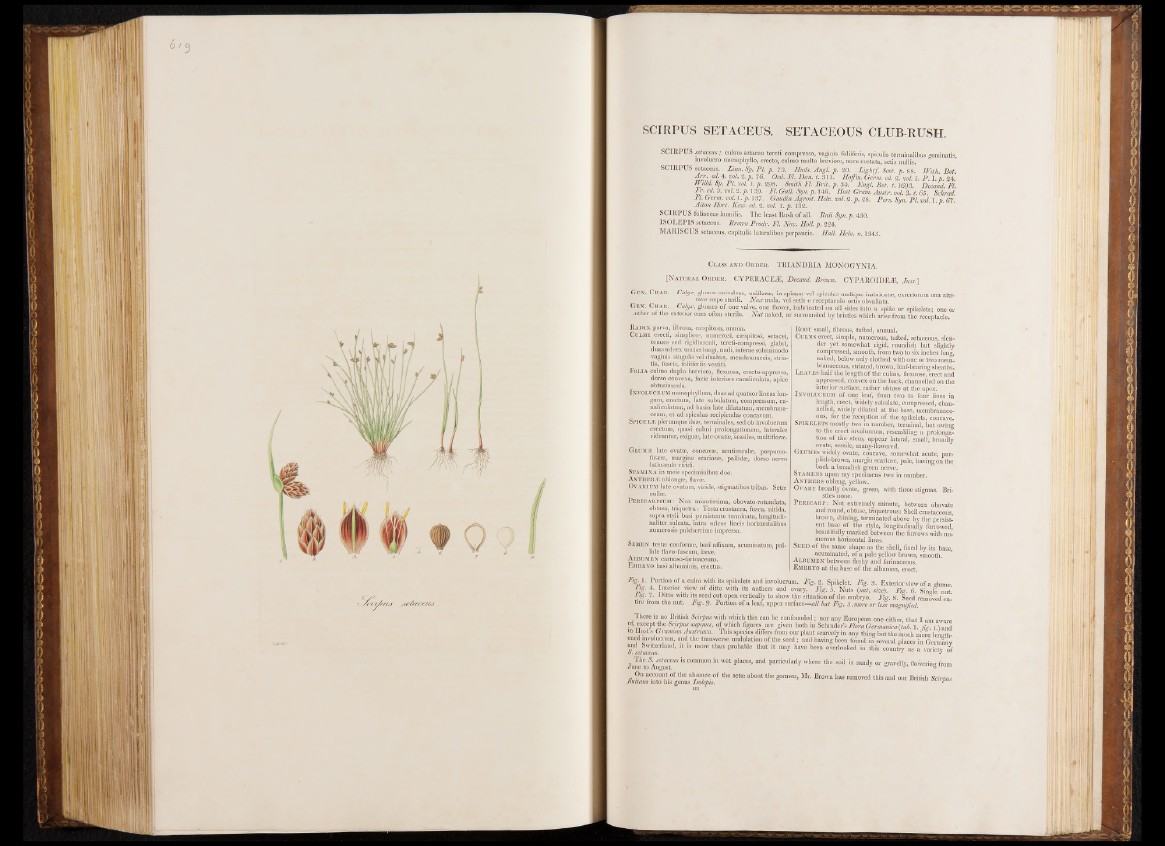
SS'C~>:' » » « » » « » e - c ■
SETACEUS. SETACEOUS CLUB-RUSH.
SCIRPUS setaceus; culmo setaceo tereti compresso, vaginis foliiferis, spiculis terrainalibus geminatis,
alte-
involucro monophyllo, erecto, culmo multo breviore, nuce costata, setis nullis.
SCIRPUS setaceus.. Linn. Sp. PL p. 73. Buds. An g l p . 20. L ig h tf Scot. p. 88. With. Bot.
Arr. ed. 4 . >ool. S. p. 76. Oed. FI. Dan, A 3 1 1 . Hoffm. Germ. ed. 2. ml. l. P . l . p 24
Willd. Sp. PI. ml. 1. p. 298. Smith Fl. Brit. p. 34. Engl. Bot. 1 .1693. Decand. FI.
Fr.ed. 3. ml. 2. p. 139- Fl. Gall. Syn.p. 1 4 6 . Host Gram. Austr. ml. 3. if. 65. Schrad.
Fl. Germ. ml. l . p . i 37. Gaudin Agrost. Helm. ml. 2 .p . 28. Pers. Syn. PI. ml. 1 . p. 67.
Aiton Hort. Kew. ed. 2. ml. 1. p. 132. 1
SCIRPUS foliaceus humilis. The least Rush of all. Rati Syn. p . 430.
ISOLEPIS setaceus. Brown Prodr. Fl. Nov. Holl. p . 224.
MARISCUS setaceus, capitulis lateralibus perpaucis. Hall. Helv. n. 134 5 .
TRIANDRIA MONOGYNIA.
[N atural O rd er . CYPERACEJE, Decand. Brown. CYPAROIDEjE, J uss.]
glumae univalves, uniflora, in spicam vel spiculas undique imbricate, exterioru
■ave stepe sterili. Nux nuda, vel setis e receptaculo ortis obvallata.
glumes of one valve, one flower, imbricated on all sides into a spike or spikelets; one or
often sterile. N u t naked, or surrounded by bristles which arise from the receptacle.
Root small, fibrous, tufted, annual.
Culms erect, simple, numerous, tufted, setaceous, slender
yet somewhat rigid, roundish but slightly
compressed, smooth, from two to six inches long,
naked, below only clothed with one or two membranaceous,
striated, brown, leaf-bearing sheaths.
Leaves half the length of the culms, flexuose, erect and
appressed, convex on the back, channelled on the
interior surface, rather obtuse a t the apex.
I nvolucrum of one leaf, from two to four lines in
length, erect, widely subulate, compressed, channelled,
widely dilated at the base, membranaceous,
for the reception of the spikelets, concave.
Spik e l e t s mostly two in number, terminal, but owing
to the erect involucrum, resembling a prolongation
of the stem, appear lateral, small, broadly
ovate, sessile, many-flowered.
G lumes widely ovate, concave, somewhat acute, purplish
brown, margin scariose, pale, having on the
back a broadish green nerve.
Stamens upon my specimens two in number.
Anth ers oblong, yellow.
Ovary broadly ovate, green, with three stigmas. Bristles
none.
Pe r ic a r p : Nut extremely minute, between obovate -
and round, obtuse, triquetrous: Shell crustaceous,
brown, shining, terminated above by the persistent
base of the style, longitudinally furrowed,
beautifully marked between the furrows with numerous
horizontal lines.
Se e d of the same shape as the shell, fixed by its base,
acuminated, o f a pale yellow brown, smooth.
Albumen between fleshy and farinaceous.
Embryo at the. base o f the albumen, erect.
F ig .\. Portion o f a culm with its spikelets and involucrum. Fig. 2. Spikelet. Fig. 3. Exterior vietv o f a glume
Fig. 4. Interior view of ditto with its anthers and ovary. Fig. 5. Nuts (pat. size). Fig. 6. Single nut'
Ditto with its seed cut open vertically to show the situation o f the embryo. Mg. 8. Seed removed entire
from the nut. Fig. 9. Portion of a leaf, upper surface—a« hut Fig. 5 .more or less magnified.
There is no British Scirpus with which this can be confounded; nor any European one either, that I am aware
of, except riie Scirpus supmus, of which figures are given both in Schrader’s Flora Germanica (tab. 1. /&• n and
in Host s Gramma Austnaca. This species differs from our plant scarcely in any thing but the much more lengthened
involucrum and the transverse undulation of the seed; and having been found in several places in Germany
and Switzerland, it is more than probable that it may have been overlooked in this country as a variety of
o. setaceus. J - ! p f
The S. setaceus is common in wet places, and particularly where the soil is sandy or gravelly flowerina from
June to August. ■ ° ° •
On account of the absence of the sette about the germen, Mr. Brown has removed this and our British Scinus
Jlmtans into his genus Isolepis. "